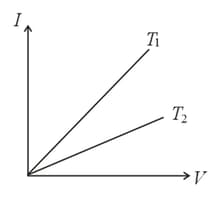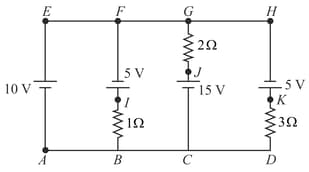A potential difference of is applied to a coil at a temperature of and the current is . What will be the temperature of the coil when the current has fallen to , the applied voltage being the same as before? Temperature coefficient of resistance .
A platinum wire has a resistance of and . Find the value of the temperature coefficient of resistance.

Important Questions on Current Electricity
The current-voltage graphs for a given metallic wire at two different temperatures and are shown in the figure. Which one is higher, or

What is the resistance measured between the two square ends?
Between two opposing rectangular faces?
The resistivity of carbon at .
In following diagram boxes may contain resistor or battery or any other element.

Then determine in each case
(a) of battery.
(b) Battery is acting as a source or load.
(c) Potential difference across each battery.
(d) Power input to the battery or output by the battery.
(e) The rate at which heat is generated inside the battery.
(f) The rate at which the chemical energy of the cell is consumed or increased.
(g) Potential difference across the box
(h) Electric power output across the box.
(a) A car has a fresh storage battery of emf and internal resistance . If the starter draws a current of , what is the terminal voltage of the battery when the starter is on?
(b) After long use, the internal resistance of the storage battery increases to . What maximum current can be drawn from the battery? Assume the emf of the battery remain unchanged.
(c) If the discharged battery is charged by an external emf source, is the terminal voltage of the battery during charging greater or less than its emf ?
electric heater is to be used with supply.
(a) What is the current in the heater?
(b) What is its resistance?
(c) What is the power dissipated in the heater?
(d) How much heat in calories is produced per second?
(e) How many grams of water at will be converted per minute into steam at ?
In following circuit potential at point is zero then determine

(a) Potential at each point.
(b) Potential difference across each resistance.
(c) Identify the batteries which act as a source.
(d) Current in each battery.
(e) Which resistance consumes maximum power?
(f) Which battery consume or gives maximum power?
